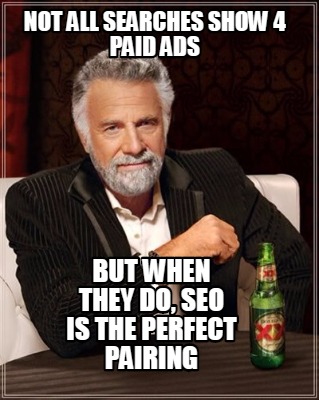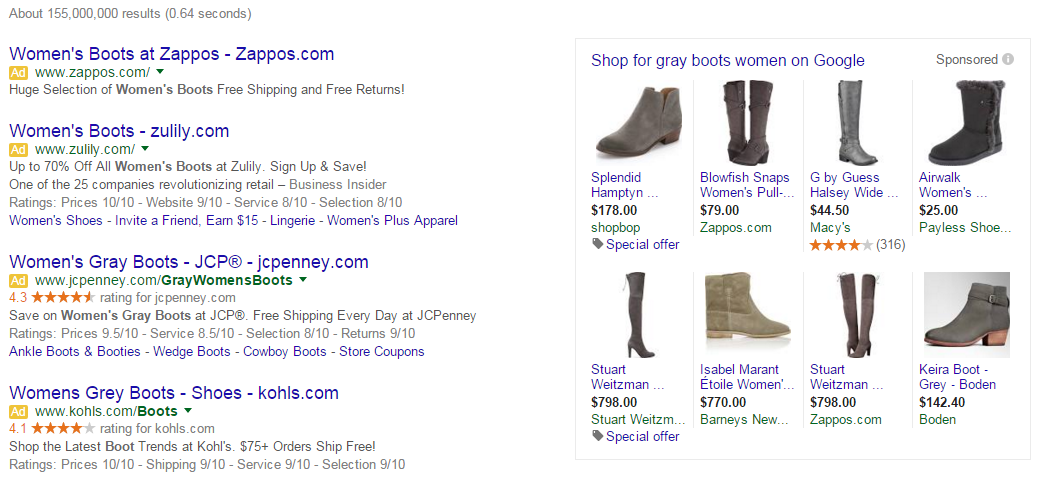They’re Gone for Good, but it May Mean New Opportunities

Google is continuing its march toward more paid ads in search results, but don’t panic! While we recommend utilizing PPC services to get customers to visit your site right when they are ready to buy, SEO remains very important. First, we’ll go over exactly what changed. Then, we’ll talk strategies for keeping your brand on the front page now and in the future.
Late last month, Google started putting four paid ads above organic listings and local search results for what it calls “highly commercial queries.” Previously, only three ads showed up on the top. In one fell swoop, the search engine giant also removed all PPC ads from the right sidebar on search results pages. All, that is, except for shopping ads with images, also known as product listings ads (PLAs). But four ads are showing up on those searches as well. See an example below.

Mobile Search is Wearing the Pants
More and more searches are made from mobile phones, and it’s been widely speculated that the change in ad placement has to do with these searches. Queries that pull up four ads on desktop searches also pull up four ads on phone and tablet searches. There are also ads at the bottom of the page, on both mobile and desktop.
What is a ‘Highly Commercial’ Query?
The change in formats was most noticeable for competitive commercial terms such as “plumbing” and “auto mechanic,” and that seems to be because such terms draw in a lot of ad revenue for Google. In fact, Google has said that four ads only show up for “highly commercial” queries. Most of the terms our clients are targeting fall into this category, for both organic search and paid search. Below is an example of what shows up above the fold on the results page for “plumbing omaha NE”.

Under these ads, in a space known in the industry as below the fold, local results pop up. Under that, regular organic listings appear. It’s important to note that in both local and organic listings, extra information such as review stars, site links and customer ratings still make an appearance.

Improve Your Odds by Understanding User Intent
Searches that don’t pull up four ads are generally ones where the searcher is looking for information or doing research unrelated to commerce. For example, a screenshot of the search below shows that no ads came up for “Catherine the Great.” However, a knowledge box did pop up in the right side bar, showing that Google is still interested in using that space.

While many queries related to business will be considered highly commercial, this opens up a great opportunity for content marketing. When you post blogs that directly answer informational queries, for example, and make sure every page on your site is full of useful information, you may be able to beat out the competition and get a spot in these above-the-fold organic results.
Will PPC be More Expensive?
Our resident PPC expert Nate Mihu has been keeping an eye on the changes and is convinced that the change won’t hurt PPC and, in fact, might make ads more effective. Most of the sidebar ads never got clicks anyway, he said, and bids for them weren’t particularly competitive. Furthermore, ads were showing up that never got clicks, basically giving freebie brand recognition for clients who weren’t willing to pay.
With four ad slots on top, it is true that bids will get more competitive, and that means more expensive. However, clients who are willing to pay are likely to get much better results. Of course, optimizing your ads is vital because cost isn’t the only thing at stake. In addition to ensuring that you have the right keywords and parameters set up, you also need to impress Google with quality scores, which take into account landing page and query relevance.
Why PPC Still Needs SEO, and Vice Versa
The best way to get noticed online is a multi-pronged strategy. Depending on your business goals and how well known your brand is, you need to strike the right balance between paid ads and website optimization. Imagine, for example, that a potential customer finds an ad for dental implants and clicks through to a landing page that offers coupons. Then, they visit the home page and services pages before deciding to make a purchase — those are solidly in the domain of organic optimization. Regardless of the customer’s path to you, you need to look your best.
Then, take the issue of branded searches, meaning queries that include brand names. Even if you have a big PPC budget, users are most likely to click on organic searches when they’re looking for a specific site. If you’re not right there on top, you may lose that prospect to a competitor.
It’s also wise to consider search behavior. Many Millenials make an effort to click on anything but ads. Increasingly, older people are doing the same, on both mobile and desktop searches.
Our clients see the most success when they show up in any available real estate on search pages, including paid ads and organic ones. If you’re interested in getting started with a paid ad campaign, improving your chances by increasing your budget, or adding SEO services to an existing PPC campaign, we would love to hear from you. Give us a ring at 801-261-5700 or fill out this form at your convenience.

